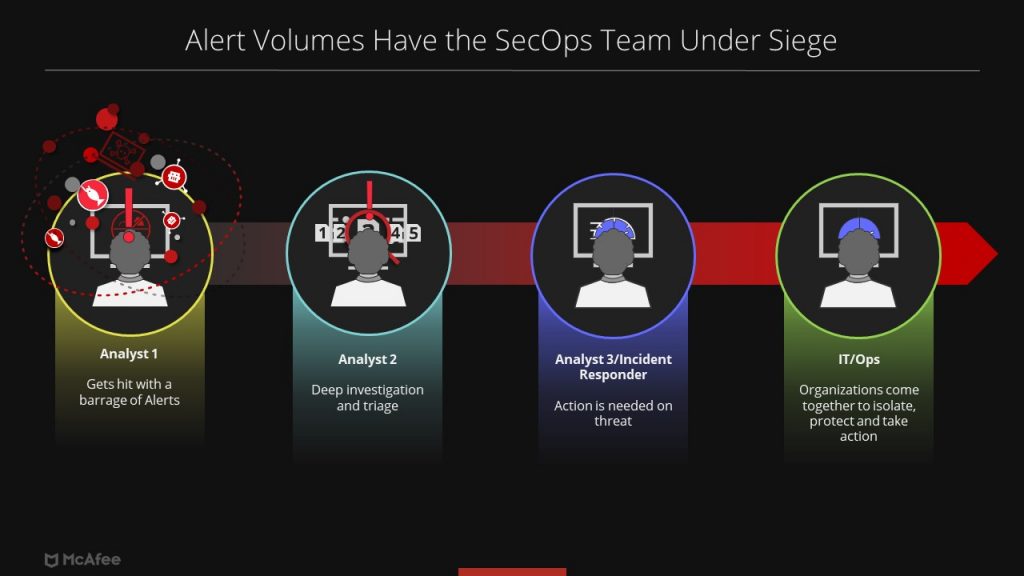The Art of Ruthless Prioritization and Why it Matters for SecOps
One of the important goals of SecOps is a faster and more effective collaboration among all personnel involved with security. The team seeks to streamline the security triage process to resolve security incidents efficiently and effectively. For this process to be optimized, we believe that ruthless prioritization is critical at all levels of alert response and triage. This ruthless prioritization requires both the processes and the supporting technical platforms to be predictive, accurate, timely, understandable for all involved, and ideally automated. This can be a tall order.

The security operations center (SecOps) team sits on the front lines of a cybersecurity battlefield. The SecOps team works around the clock with precious and limited resources to monitor enterprise systems, identify and investigate cybersecurity threats, and defend against security breaches.
Depending on the enterprise size and industry, these tools may generate many thousands of alerts in periods ranging from hours to days, and many of them may be redundant or no value. One vendor surveyed IT professionals at the RSA conference in 2018. The survey results show that twenty-seven% of IT professional’s receive more than 1 million security alerts daily[1].
Alert Volumes Have the SecOps Team Under Siege
Most SecOps teams are bombarded with an increasing barrage of alerts each year. A recent IBM report also found that complexity is negatively impacting incident response capabilities. Those surveyed estimated their organization was using more than 45 different security tools on average and that each incident they responded to required coordination across around 19 security tools on average.
Tier 1 SecOps analysts have to manage this barrage of alerts. They are surrounded by consoles and monitors tracking many activities within enterprise networks. There is so much data that incident responders cannot process but a fraction of it. Alerts pour in every minute and ratchet up the activity level and the attendant stress throughout the day.
The cost and effort of reviewing all of these alerts are prohibitive for most organizations, so many are effectively deprioritized and immediately ignored. Some surveyed respondents admit to ignoring specific categories of alerts, and some turn off the security alerts associated with the security controls that generate much of the alert traffic. However, the one alert you ignore may have resulted in a major data breach to the organization.
Once the alert is determined to be potentially malicious and requires follow-up it is escalated to a Tier 2 SOC Analyst. Tier 2 SOC Analysts are primarily security investigators. Perhaps only 1% or less are escalated to a Tier 2 SOC analyst for deep investigation. Once again, the numbers can vary substantially depending on the organization and industry.
A Tier 1 SecOps analyst processes up to several hundred alerts in a day that require quick review and triage. As the alert is logged, the Tier 1 SecOps analyst usually goes through a checklist to determine further prioritization and determine if further escalation is required. This can vary substantially depending on the automation and tools which support their efforts.

Security investigators will use a multitude of data, threat intelligence, log files, DNS activity, and much more to identify the exact nature of the potential breach and determine the best response playbook to use. In the case of a severe threat, this response and subsequent remediation must be done in the shortest possible amount of time, ideally measured in minutes if not just a very few hours.
Given the barrage of alerts, it is essential to adopt a strategy to fit best the capabilities of your team against a priority-driven process. This allows you to optimize your response to alerts, best manage the resources on the SecOps team, and reduce the risk of a dangerous breach event.
In the most dangerous scenario that a threat actor has executed what is determined to be a zero-day attack, the SOC team works with IT, operations, and the business units to protect, isolate, and even take critical servers offline to protect the enterprise. Zero-day attacks raise the SOC to a war footing, which, if properly and rapidly executed against the team’s playbooks, can help mitigate further damage from what is otherwise previously unknown attack techniques. These require the skill and expertise of advanced security analysts to help assess and mitigate complex ongoing cyberattacks.
A Data-Driven Approach to Prioritization
The first approach to prioritization, consistent with the tenets of zero trust, is to take a data-driven approach. Customer data and intellectual property are often at the center of every organization’s most protected jewels. One way to move this into focus within SecOps would be to implement Data Loss Prevention (DLP). Data loss prevention (DLP), per Gartner, may be defined as technologies that perform both content inspection and contextual analysis of data sent via messaging applications such as email and instant messaging, in motion over the network, in use on a managed endpoint device, and at rest in on-premises file servers or in cloud applications and cloud storage. These solutions execute responses based on policy and rules defined to address the risk of inadvertent or accidental leaks or exposure of sensitive data outside authorized channels.
There are several strategic views that SOC leadership can take on how to best approach prioritization. These include data driven strategies using tools like DLP, threat driven strategies to bolster defenses and shorten reaction time to threat vectors active in your industry and geography, and perhaps asset driven strategies, where certain assets will merit enhanced protection and priority driven escalation for alerts. Most organizations find that an integrated mix of these strategies addresses their overall needs.
A Threat-Driven Approach to Prioritization
Threat intelligence focuses on defense and triage priority from the data to external threat actors and the techniques they are most likely to utilize. Threat intelligence can give the SOC the data they need to anticipate threat actors and the Tactics, Techniques, and Procedures (TTPs) these threat actors might use. Further, threat intelligence can provide a path to recognize the often unique Incidents of Compromise (IOCs) that can uniquely identify a type of cyberattack and the threat actor that uses them. The goal, of course, is to identify and prevent these most likely attacks before they occur or stop them rapidly upon detection.
Enterprise DLP solutions are comprehensive and packaged in agent software for desktops and servers, physical and virtual appliances for monitoring networks and email traffic, or soft appliances for data discovery. Integrated DLP works with secure web gateways (SWGs), secure email gateways (SEGs), email encryption products, enterprise content management (ECM) platforms, data classification tools, data discovery tools, and cloud access security brokers (CASBs).
In August of 2020, researchers from Dutch and German universities[2] co-presented at the 29th Usenix conference on a survey they conducted. The survey showed that there is less overlap between threat intelligence sources than most of us would expect. This includes both open (free) and paid threat intelligence sources. The moral of the story is that large organizations likely need a wide set of threat intelligence data from multiple sources to gain an advantage over threat actors and the attack vectors they are likely to use. And these sources must be integrated into a common dashboard where SecOps threat investigators can rapidly leverage them.
The consolation prize is also a good one. If you cannot prevent an attack, you must be able to identify an unfolding threat. You must identify the attack, break the attacker’s kill chain, and then stop the attack. Threat intelligence can also help you assess your environment, understand the vulnerabilities that would support the execution of a particular kill chain, and then let you move rapidly to mitigate these threats.
Optimize Your Prioritization Strategy with MVISION XDR
MVISION XDR provides capabilities leveraging all of these prioritization strategies: data-driven, threat-driven, and asset-driven. On top of this MVISION XDR offers predictive assessment based on global threats likely to target your organization with a local assessment of how your environment can counter the threat. This “before the attack” actionable assessment is powered by the distinct MVISION Insights empowering SOC to be more proactive and less reactive. Here is a preview of MVISION Insights top ten threat campaigns. Here are some key prioritization examples delivered in MVISION XDR:
An Asset-Driven Approach to Prioritization
Of course, certain assets are more valuable than others. This can be a function of the data they may uniquely hold, and the access to network, applications, and information resources frequented by their owners, or the level of criticality of the asset’s function. For example, the chief financial officer’s laptop may be assumed to be in possession of the most sensitive data, or medical device monitor during surgery or command controller for manufacturing production. Hence they may deserve higher priority in terms of protection.
Key MVISION XDR Prioritization Examples
| Priority Strategy (ies) | Capability Description | Benefit & Value |
| Data-driven | Alert based on data-sensitivity | Focus on critical impact activity |
| Threat-driven | Automatic correlated threat techniques to derive at likely next steps | Gain confidence in the alert less false positives |
| Threat-driven | View trends and threat actors targeting your organization | Reduce the universe of threats and actors to those that matter |
| Asset-driven | Tag critical assets for automated prioritization | Address threats to critical assets faster |
Prioritization Delivers Improved Business Value for the SecOps Team
MVISION XDR can help you implement and optimize your prioritization strategy. Your SecOps team will have the improved triage time they need with prioritized threats, predictive assessment, and proactive response, and the data awareness to make better and faster decisions. To learn more, please review the MVISION XDR solution brief or reach out to our sales team directly.
[2] https://www.usenix.org/system/files/sec20_slides_bouwman.pdf
[1] https://www.imperva.com/blog/27-percent-of-it-professionals-receive-more-than-1-million-security-alerts-daily/
The post The Art of Ruthless Prioritization and Why it Matters for SecOps appeared first on McAfee Blogs.
This post was first first published on McAfee Enterprise – McAfee Blogs’s website by Randy Kersey. You can view it by clicking here

